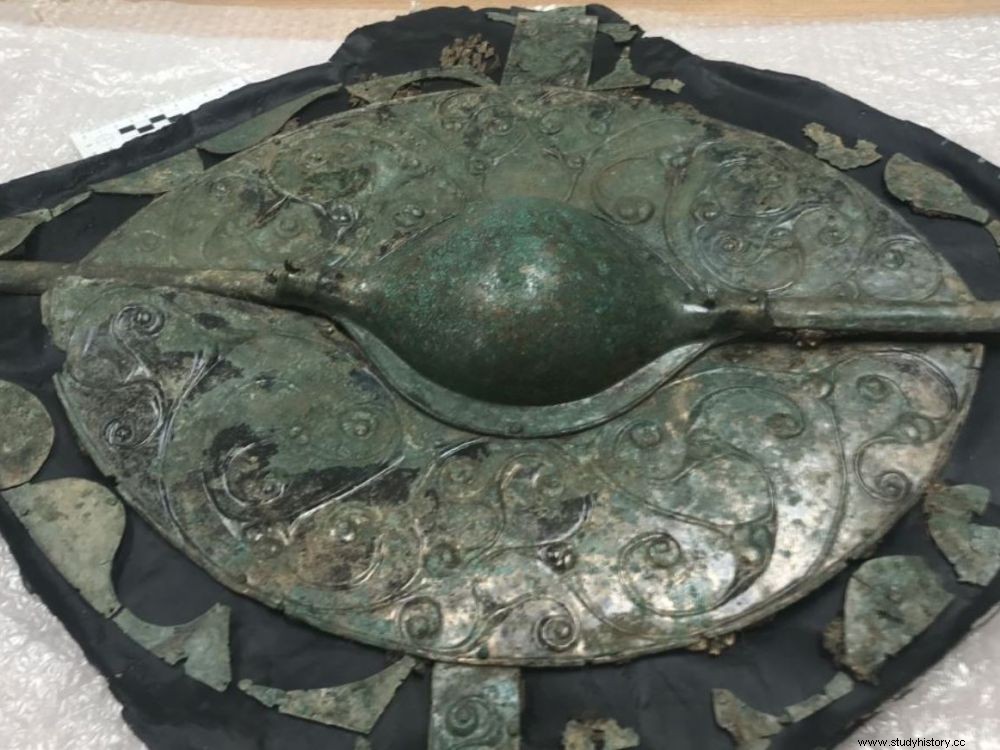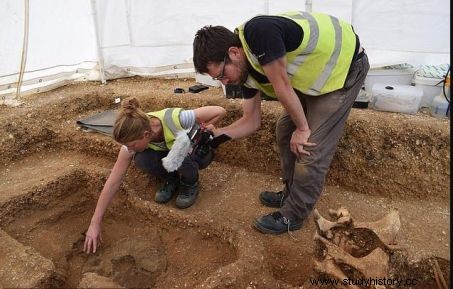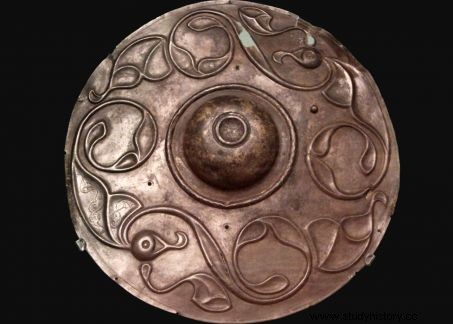In a 2,200-year-old burial, archaeologists have unearthed an impressive Iron Age chariot and shield which they consider one of the most important discoveries made in recent decades in the United Kingdom.

Remarkably preserved Iron Age shield. Found in Yorkshire, it has been hailed as "the most important British Celtic art discovery of the turn of the millennium".
The election result across the Channel is not the only event to make headlines in recent days in Britain. The discovery of a Celtic chariot and a bronze shield in an exceptional state of preservation also stunned the British, archaeologists even speaking of "discovery of the century" for England! They were exhumed from a "chariot grave" located in the heart of the Celtic necropolis of Pocklington, east Yorkshire, during preventive excavations carried out in July 2018, but the results of which have only just been released. unveiled.
The funeral chariot contained a spectacular shield 75 cm in diameter
They had been placed in a large burial chamber, no doubt made of wood – which has since disappeared – designed to accommodate this two-wheeled battle tank still equipped with its drawbar [piece of wood to which the horses were harnessed]. A man in his forties was buried there, curled up, dressed, and still carrying two bronze fibulae (brooches). "Food offerings of pork had been placed with him, as well as a meat fork, a banqueting instrument" , explains archaeologist Laurent Olivier, Chief Heritage Curator, responsible for the Celtic and Gallic archeology collections at the National Archeology Museum in Saint-Germain-en-Laye (Yvelines), joined by Sciences et Avenir.

Extraction of the Celtic shield from the war chariot of Pocklington (Yorkshire), when it was discovered. © MAP Archaeological Practice Ltd
Above all, the funeral chariot contained a spectacular shield 75 cm in diameter, considered a masterpiece of European Celtic art. "Its central part ("umbo") is inscribed in an almond-shaped bronze plaque, covered with an ornamentation of nets based on interlocking trisceles , adds Laurent Olivier. The virtuosity and style of the motifs on this shield are reminiscent of that of Wansworth [found in the Thames in 1849, and held in the collections of the British Museum in London] as well as another piece found at Torrs Loch, Scotland. These designs emanate from an insular stylistic home that flourished primarily in the 3rd century BC."

Celtic shield from Wandsworth (2nd century BC), discovered in 1858 at the bottom of the Thames. © British Museum
That's not all ! The skeletons of two small horses were found, still hitched to the chariot. "This is the first time in Britain that a chariot grave has revealed the presence of sacrificed horses staged in a racing position!" , continues the researcher. Ready to pounce, they evoke the couple of horses from the Celtic chariot tomb discovered at Sboryanovo, near Svestari, in northeastern Bulgaria and whose Sciences et Avenir echoed (read n°868, June 2019 ). "This type of burial in which the dead is placed in a bent position on his chariot is characteristic of the archaeological culture known as Arras (from the name of a site British identified in the 19th century), a culture which extends mainly over the eastern part of the present territory of Yorkshire ", specifies Laurent Olivier. A culture dated from the 3rd to the beginning of the 2nd century BC, attributed to the British Celtic people of the Parisii established in the North East of England which directly evokes the… Parisii of the Paris Basin!
"Disturbingly, the chariot tombs of the Arras culture not only stand out from local burial practices of the same period, but are directly reminiscent of the numerous ones unearthed in northern Gaul! quite similar burial practices thus seem to respond to each other at a distance during the 3rd c. BC." . Was "Pocklington's Warrior", who clearly belonged to the dominant social strata of Celtic society in Britain, dependent on a community of continental Celts who settled in Britain? The isotopic and paleogenetic studies of the human remains of Pocklington should soon make it possible to answer this intriguing question.
